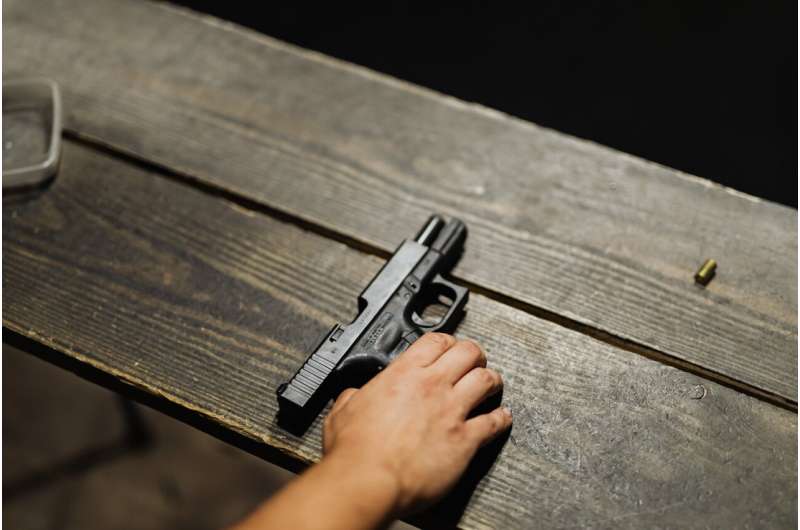This article has been reviewed according to Science X's editorial process and policies. Editors have highlighted the following attributes while ensuring the content's credibility:
fact-checked
peer-reviewed publication
trusted source
proofread
Firearm injuries among children and adolescents lead to huge mental and behavioral health consequences: Study

The alarming increase in firearm injuries to children and adolescents in the United States has taken an enormous mental and behavioral health toll on victims, survivors, and their families, with ripple effects on the economy and health care spending, researchers from Massachusetts General Hospital (MGH) and Harvard Medical School (HMS) have found.
In a study published in the November issue of Health Affairs, the team cited the substantial opportunities for improvements in clinical practice for survivors of gun violence and their family members, such as improved screening for mental and behavioral health needs, as well as enhanced educational programs for the clinicians who treat them.
The study did not include those affected by the recent gun violence in Lewiston, Maine, but the strategies outlined within could help to inform long-term strategies to help survivors heal.
"Children are increasingly exposed to firearms, and our study shows the magnitude of medical, psychological and economic effects of both non-fatal and fatal firearm injuries on survivors, family members and society," says lead author Zirui Song, MD, Ph.D., a general internist at MGH and health economist at HMS.
"We believe these findings can better inform the clinical care of people affected by firearm injuries—not only survivors who face often challenging roads to recovery, but also their siblings, parents and potentially other loved ones."
"Our study shines light on the substantial effects incurred not just directly by victims and survivors of gun violence, but indirectly by parents and siblings who, we found, often relinquish their own routine health care to the more acute health needs of the family," notes senior author Chana Sacks, MD, MPH, co-director of the MGH Gun Violence Prevention Center, which she co-founded after her cousin's seven-year-old son was killed in the Sandy Hook elementary school shooting.
"Improved health systems rooted in trauma-informed approaches are essential to ensure those indirectly affected by firearm injuries are identified and able to access much needed care," Sacks continued.
Since 2020, more children and adolescents in America have died from firearms than any other cause, an increase of 87% from a decade ago. Alongside this increase in deaths, many more youth in America each year are shot but survive.
Rigorous evidence of the impact this national epidemic has had on victims and their families has been limited. Most studies of firearm injury survivors, in fact, have excluded children.
MGH researchers, together with investigators at HMS and the Boston Health Care for the Homeless program, tackled the issue through an observational study that compared 2,052 child and adolescent survivors of firearm injuries and 6,209 of their family members to much larger matched control groups that did not incur firearm injuries.
The study also included 265 family members of children who died from gunshots, along with its own matched control group.
The team found that one year after firearm injuries, child and adolescent survivors experienced a 117% increase in pain disorders, a 68% increase in psychiatric disorders, and a 144% increase in substance use disorders relative to the controls.
Moreover, parents of survivors experienced a 31% increase in psychiatric disorders—with 75% more mental health visits by mothers—while family members of children who died registered a substantially larger 2.3- to 5.3-fold increase in psychiatric disorders, with a 15-fold increase in mental health visits among mothers and 87-fold among fathers.
From an economic perspective, the study found that health care spending by survivors through the first year of firearm injuries rose by an average of $34,884, with approximately 95% paid by insurers or employers (though ultimately these costs cut into wages).
This 17-fold increase in spending underscored how much firearm injuries radiate out from individual families to affect the broader economy and societal resources.
Past estimates have posited that the total economic toll of gun violence in this country is $557 billion a year, of which 88% can be accounted for by quality-of-life losses among victims and their families.
For Song, a more comprehensive response by the health care system to firearm injuries requires improved screening for mental and behavioral health conditions afflicting not just these victims, but their wider circle of family and friends.
"Health care professionals have an opportunity to be more aware of the unique needs of this ever-growing community," he points out. "Engaging in clinically and culturally informed discussions with victims and family members could identify easily overlooked gaps in care, such as routine doctor visits foregone by family members, and help them in their healing."
Song is an internist in the Division of General Internal Medicine at MGH and associate professor of health care policy and medicine at HMS. Senior author Sacks is a clinician investigator in the division of General Internal Medicine at MGH and assistant professor of Medicine at HMS.
Co-authors include Jose Zubizarreta, Ph.D., a professor in the department of Health Care Policy, HMS; Mia Giuriato, MA, a director of analysis in the department of Health Care Policy; and Katherine Koh, MD, MSc, a psychiatrist at MGH and the Boston Health Care for the Homeless Program and assistant professor of psychiatry at HMS.
More information: Firearm Injuries In Children And Adolescents: Health And Economic Consequences Among Survivors And Family Members, Health Affairs (2023). DOI: 10.1377/hlthaff.2023.00587. www.healthaffairs.org/doi/abs/ … 7/hlthaff.2023.00587



















